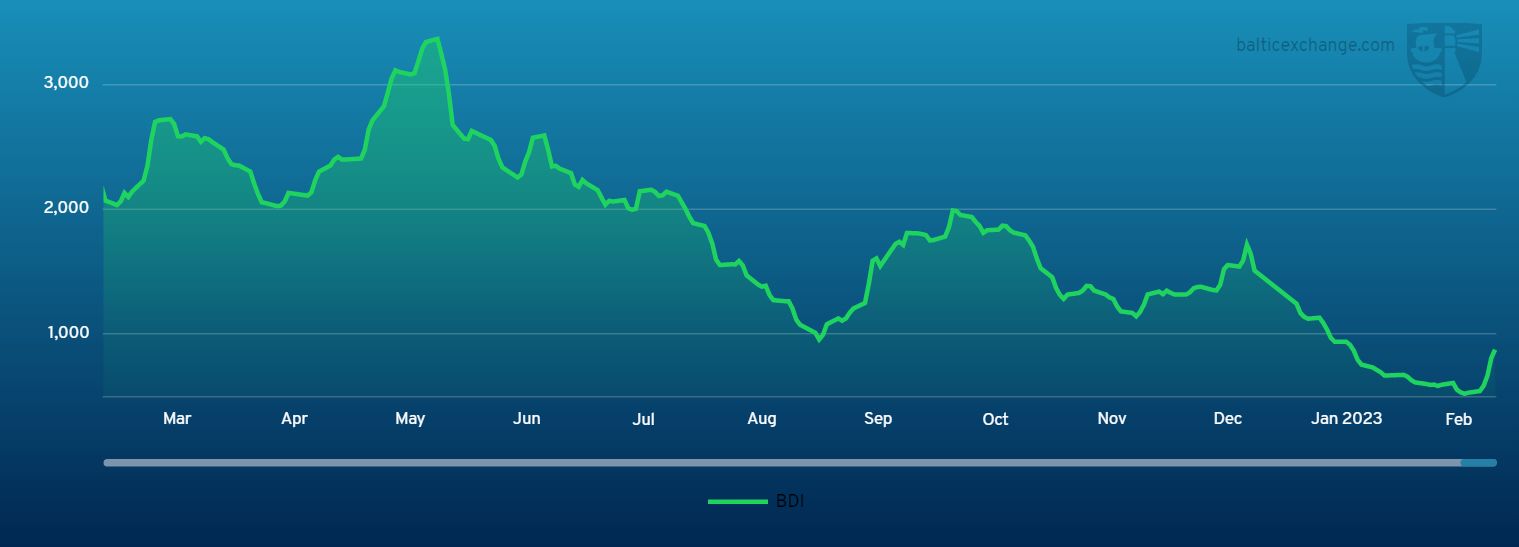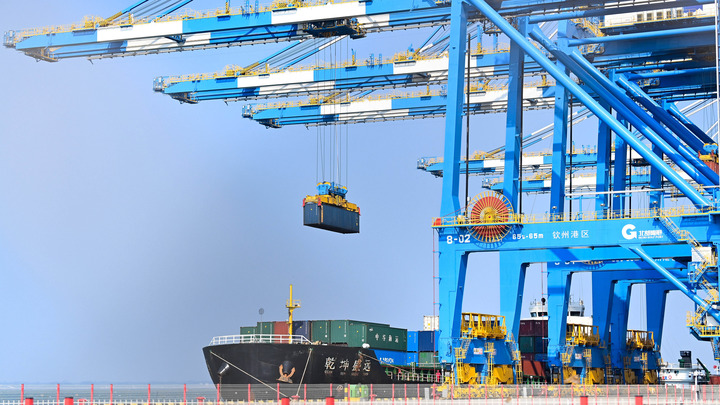BEIJING, Feb. 27 (Xinhua) -- The Baltic Exchange has published its weekly report of the dry and tanker markets for February 20-24, 2023 as below:
Capesize
Results from Rio Tinto and BHP disappointed this week, but there was hope that with China reopening it would lead to more cargo. In the end, that certainly seemed to be the case. There was a complete change in seven days as activity was reported from West Australia and in the Atlantic. Not a great deal was reported from Brazil. However, there was enough activity for the indices to all jump significantly. Last Friday the 5TC was at $2,246 and as we close the week it stands at $5,271. Rates from West Australia to China jumped a dollar to near $7, C3 from Brazil with limited activity was trading up slightly in the low to mid $17s. As reported last week the market needs cargo and there is optimism from Owners that the market is turning. But in its fragile state at present it could turn again quickly.
Panamax
The Panamax market surged into life this week for the first time in 2023. This was fueled largely by firmer demand ex EC South America for mid-March arrivals and ably supported by a buoyant FFA market. All basins subsequently witnessed sizeable gains. Rates of $13,000 + $300,000 agreed early part were now achieving $16,000 + $600,000 on Friday, albeit decent spec tonnage for trips via EC South America redelivery Singapore-Japan. The North saw Transatlantic rates achieve double digits too for the first time in a while. Asia, not to be outshone, also saw solid support over the week - particularly from Indonesia and the Australia to India coal runs with excess $12,000 agreed a couple of times. Grain round trips ex Australia also gained momentum with premium rates rumoured fixed for grain clean tonnage. Period interest naturally grew and there were reports in the early part of the week of an 81,000dwt delivery China agreeing high $15,000’s basis five to seven months.
Ultramax/Supramax
A stronger week for the sector with gains made in both basins. The Atlantic saw better activity from the South Atlantic and with more fresh enquiry rates pushed higher from the US Gulf. That said, the Continent remained finely balanced with limited fresh opportunities for owners. From Asia, an influx of prompt requirements from South East Asia buoyed the market and saw vessels being sought from the north to cover the demand. Period cover was sort and a 63,000dwt open Dammam fixing four to six months trading at $15,500. There was talk of a 63,000dwt open Mediterranean for one year with redelivery in the Atlantic at $15,000. From the US Gulf a 63,000dwt was fixed for a petcoke run to the Far East at around $20,000. Further south, a 56,000dwt fixed delivery NC South America for a Transatlantic run at $13,000. Asia saw a 58,000dwt open Malaysia fixing a trip via Indonesia to China at $16,500. Further north, a 63,000dwt was heard fixed delivery North China for a trip via Indonesia redelivery South east Asia in the upper $12,000s.
Handysize
A week of positivity across the sector. East Coast South America led the charge in the Atlantic, with a 37,000dwt fixing from Recalada to the Mediterranean at $14,000 whilst another 37,000dwt fixed from Recalada to the Caribbean at $14,000. In the Mediterranean, a 38,000dwt fixing from Oran to North Coast South America with cargo of clinker at $9,250. The US Gulf showed its first shoots of positivity with a 34,000dwt rumoured to have fixed a trip from the US Gulf to Portugal with an intended cargo of Petcoke at $8,750. In Asia, a 38,000dwt was fixed from Indonesia via Western Australia to Indonesia with an intended cargo of grains at $10,000. A 34,000dwt was fixed from Brisbane to Japan with a cargo of sugar at $13,000 and period was also active with a 37,000dwt rumoured to have been fixed for 10 to 13 months at $14,000.
Clean
The majority of the Baltic Exchange CPP freight routes have fallen this week, which was reflected in the BCTI dropping to under the 1000 mark.
In the Middle East, LRs have taken a tumble after improving. On the LR2s TC1 peaked at just over WS200 midweek to return back to WS194.38. Similarly, a TC20 run to the UKC topped out at $4,770,000 (up from $4,614,000) and finally settled at $4,714,000 by the end of the week. Much like their larger counterparts LR1s have come off this week. TC5 has lost 7.58 points to WS209.29 and TC8 (65kt MEG/UK-Continent) shed $100,100 down to $3,866,850. Despite these drops LR2s are still returning around $50,000 /day and LR1s $40,000 /day round-trip TCE. On the MRs TC17 has been retested down, and WS325 has been reported on subjects more than once, leading the index down 58.57 points to WS321.43.
West of Suez the LR2s of TC15 have remained balanced around the $3,900,000 – $4,100,000 mark all week. There has been a little more activity on the LR1s this week, but despite this TC16 dropped to WS200 (-12.14).
UK-Continent MRs have been consistently under the cosh this week, attributed to a surplus of tonnage outweighing demand. TC2 has lost 66.11 points to WS193.33 and likewise TC19 came down from WS268.57 to WS202.86.
Handymax vessels have been feeling the pressure just as the MRs have this week. TC6 has lost 27.25 points to WS237.13, and on the UK-Continent TC23 dropped to WS261.25 (-31.25).
In the Americas, just as the MRs recouped last week, they have been slashed back down this week. TC14 dipped 66.67 points to 125.83 and TC18 was cut down to WS211.67 (-84.16). A run to the Caribbean (TC21) has also taken a 44% hit and is currently pegged at $693,750 (-$543,750).
VLCC
The VLCC rates took a slightly negative turn this week, with the exception of the US Gulf to China route.
For the 270,000mt Middle East Gulf to China voyage the rate eased 3.5 points to WS4.73, which shows a daily round voyage TCE of $47,300 basis the Baltic Exchange’s vessel description. The rate for 280,000mt Middle East Gulf to US Gulf (via the cape/cape routing) is assessed one point lower at WS40.5.
In the Atlantic markets, the rate for 260,000mt West Africa/China slipped one point to about WS66.5 showing a round-trip TCE of $49,900 per day. This is $2,700 more than a week ago. The rate for 270,000mt US Gulf/China swung upwards by over $325,000 to just over $9.322 million ($43,300 per day round-trip TCE) and overnight reports today have details of Occidental on subjects with a Trafigura relet (2017 built scrubber fitted) at $9.4 million for this trip.
Suezmax
The rate for 135,000mt CPC/Augusta softened by one point this week to WS167 (a round-trip TCE of $87,900 per day). In West Africa, for the 130,000mt Nigeria/Rotterdam voyage, rates firmed by almost 10 points to WS136 (a daily round-trip TCE of $62,500). In the Middle East, the rate for 140,000mt Basrah/Lavera gained two points to WS60, with tonnage availability reportedly diminishing.
Aframax
In the North Sea market, rates for the 80,000mt Hound Point/Wilhelmshaven route remained flat at around WS152.5-153.5 (a round-trip daily TCE of $50,800).
In the Mediterranean, the rate for 80,000mt Ceyhan/Lavera dropped four points to WS174.5 (a daily round-trip TCE of $56,100).
On the other side of the Atlantic, the Stateside Aframax market sharply rose. The rate for 70,000mt East Coast Mexico/US Gulf improved by 68 points to WS267.5 (about $90,100 per day round-trip TCE) while the rate for 70,000mt Covenas/US Gulf had 64 points added to last week’s rate to WS257 (a daily round-trip TCE of $79,000).
For the Transatlantic route of 70,000mt US Gulf/Rotterdam, rates are up by 24 points at about WS242.5 (showing a round-trip TCE of $70,700 per day).
LNG
The BLNG1g route rose slightly and is beginning to shift away from the flat market we have seen of late. Enquiry on the spot continues to increase. And although cargoes are looking for vessels available open prompt, there is a slight disconnect between owners and charterers ideas. The Australia-Japan run finished at $75,702 rising over $6,000 and holding its own against the US routes, which are falling a little behind.
For the US runs, both BLNG2g and BLNG3g increased with the continued opening of Freeport. The prospect of further cargoes in the mix could open up the ARB and overtake the BLNG1g levels. However, at the moment there’s still a discount vs the East with BLNG1g closing at $56,597 and BLNG3g $68,675.
Period discussions continue to focus on sublet tonnage. There is less demand vs the spot, but rates are still increasing on one and three-year terms. Current estimations for a 174k 2-Stroke vessel with 0.085% boil off and delivery one month ahead: $183,000 for 12 months, and $167,00 for three years.
LPG
Rates rose this week over $7.5 on the back of a spate of fixing and a strong uptick in the US market, which has attracted ships away from the AG. This activity, coupled with uncertain itineraries, has created a tighter position list and pushed sentiment higher. Rates for a Ras Tanura-Chiba BLPG1 run rose to end at $102.714. This is the first time we have seen the route back into triple digits since the end of December 2022.
The US market took off, rising over $22 on a Houston-Chiba BLPG3 route to close at $159.571 (having briefly touched $160 mid-week). This pushed TCE earnings up for owners to $85,698 daily return on a round voyage. A vessel fixed for mid-April dates was done so at $159 Houston-Chiba. And with enquiry still looking for later in the month there are expectations that this premium over the AG should remain. With less fixed on BLPG2 Houston-Flushing, rates rose slightly less, but still quite a healthy amount, to close at $91.2 (a rise of just over $14 on the week). This gave a TCE daily return on a round voyage of $102,918.
Headquartered in London and a subsidiary of the Singapore Exchange (SGX), the Baltic Exchange publishes a range of indices and assessments which provide an accurate and independent benchmark of the cost of transporting commodities and goods by sea. These include the Baltic Dry Index (BDI), the dry bulk shipping industry's best known indicator. Published daily since 1985, this provides a snapshot of the daily spot market earnings of capesize, panamax and supramax vessel types on the world's key trading routes.

Chart shows Baltic Dry Index (BDI) during Feb. 25, 2022 to Feb. 24, 2023

Baltic Forward Assessment for BDI
In March 2018 the BDI was re-weighted and is published using the following ratios of time charter assessments: 40 percent capesize, 30 percent panamax and 30 percent supramax. The information is provided by a panel of international shipbrokers.
(Source: The Baltic Exchange, edited by Niu Huizhe with Xinhua Silk Road, niuhuizhe@xinhua.org)




 A single purchase
A single purchase









